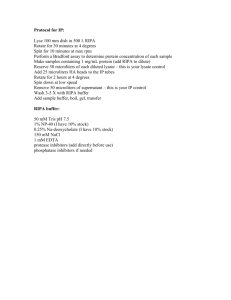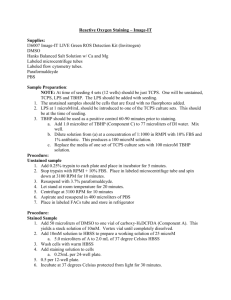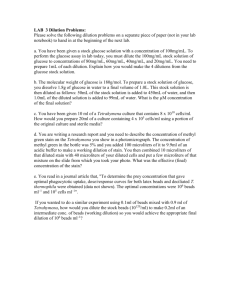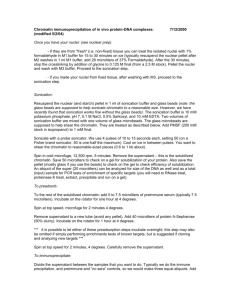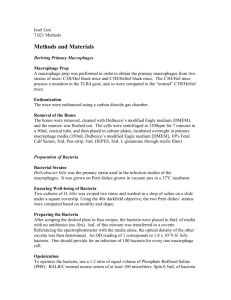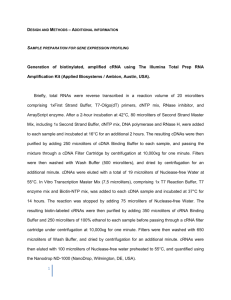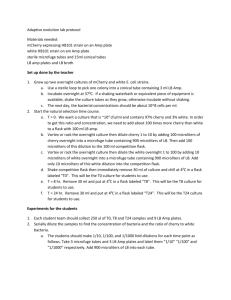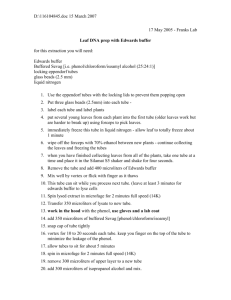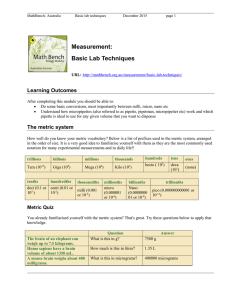Here`s - MathBench
advertisement
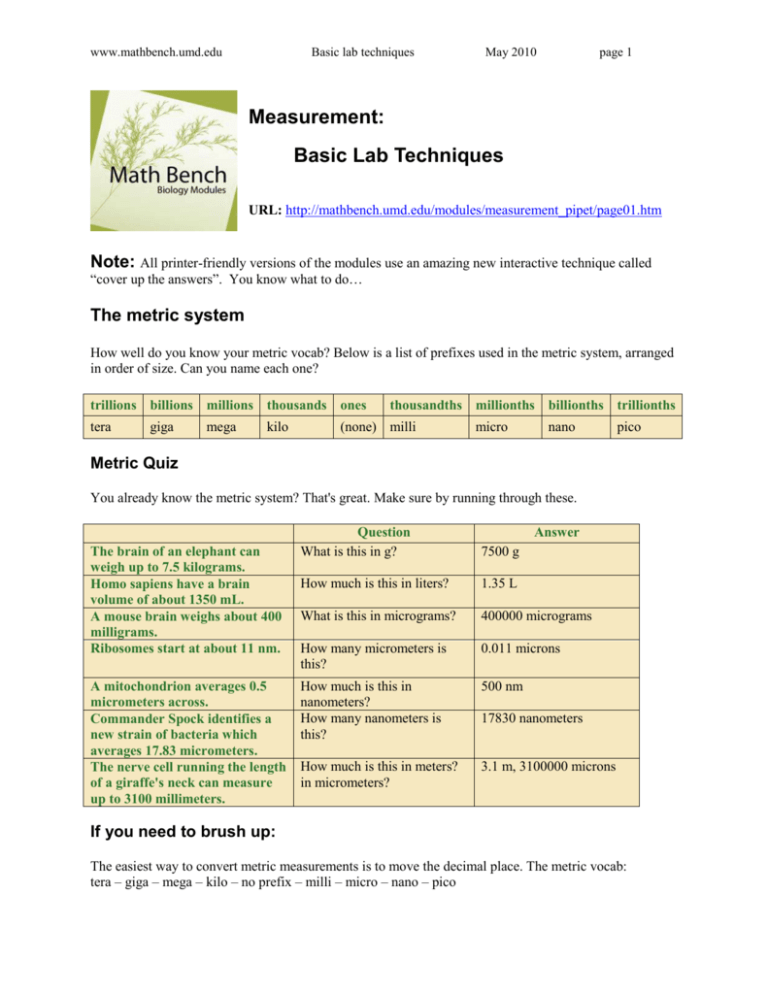
www.mathbench.umd.edu Basic lab techniques May 2010 page 1 Measurement: Basic Lab Techniques URL: http://mathbench.umd.edu/modules/measurement_pipet/page01.htm Note: All printer-friendly versions of the modules use an amazing new interactive technique called “cover up the answers”. You know what to do… The metric system How well do you know your metric vocab? Below is a list of prefixes used in the metric system, arranged in order of size. Can you name each one? trillions billions millions thousands ones tera giga mega kilo thousandths millionths billionths trillionths (none) milli micro nano pico Metric Quiz You already know the metric system? That's great. Make sure by running through these. The brain of an elephant can weigh up to 7.5 kilograms. Homo sapiens have a brain volume of about 1350 mL. A mouse brain weighs about 400 milligrams. Ribosomes start at about 11 nm. A mitochondrion averages 0.5 micrometers across. Commander Spock identifies a new strain of bacteria which averages 17.83 micrometers. The nerve cell running the length of a giraffe's neck can measure up to 3100 millimeters. Question What is this in g? 7500 g Answer How much is this in liters? 1.35 L What is this in micrograms? 400000 micrograms How many micrometers is this? 0.011 microns How much is this in nanometers? How many nanometers is this? 500 nm How much is this in meters? in micrometers? 3.1 m, 3100000 microns 17830 nanometers If you need to brush up: The easiest way to convert metric measurements is to move the decimal place. The metric vocab: tera – giga – mega – kilo – no prefix – milli – micro – nano – pico www.mathbench.umd.edu Basic lab techniques May 2010 page 2 Every time you move to the right on this list, the unit gets smaller (by 3 decimal places), so you need more of them to compensate (move the decimal place 3 to the right). For example, an ostrich egg can be up to 0.12 meters. What if you need to convert this to millimeters? Since millimeters are smaller than meters, you will need more of them to cover the egg. So, move the decimal 3 places to the right: To convert to a larger unit, you need to move the decimal place to the left. For example, a microtubule is 25 nm in diameter. To convert the microtubule length to micrometers, you need to move the decimal place 3 to the left (so that there will be fewer micrometers than nanometers). So, If you need to convert between two prefixes that are not next to each other (i.e., milli to nano), just add up all the decimal places (in this case, 6 decimal places to the right). For example, a human egg is 0.1 millimeters in diameter. So, in nanometers, this is: To summarize, remember that the SMALLER the unit, the MORE of them you need to make the same measurement, so move the decimal in the appropriate direction. How to select a micropipetter 1. you need to know which pipetman to choose. 2. you need to know how to interpret the numbers on the volume indicator. www.mathbench.umd.edu Basic lab techniques May 2010 page 3 There are 3 standard sizes of pipetman, called a P20, a P200, and a P1000. They measure up to 20, 200, or 1000 microliters, respectively. The rule for choosing between them is simple: use the smallest pipetman you can, but don't exceed the capacity of the pipetman. For example, say you need to measure out 25 microliters of a solution. 25 is too big to fit into a P20, so DON'T DO IT, ok? 20 will fit in a P200 or a P1000, so pick the smaller one. That way you'll get a more precise measurement. Here's an analogy. Say you need to measure ½ gallon of milk. Which would you rather use, a one-gallon jug, or a five-gallon bucket? Right, the one-gallon jug. Pick the smallest measuring device that will hold the quantity needed. Oh, yeah, then get the tip. This part is easy because they're color-coded: Yellow plunger = yellow (or clear) tip . Blue plunger = blue tip. Not exactly rocket science. Which Tip is Which? Questions Some superfast glucometers require as much as 25 microliters of blood. Which pipetman would you use to measure this amount? Answer P200. 25 microliters won't fit in a P20, so you have to use the P200 Part of the process of making glucose test strips for diabetes involves pipetting 210 microliters of glucose oxidase into the reactive mixture. Which pipetman should be used for this purpose People with diabetes need to measure their blood sugar using a glucometers which requires a sample of up to 12 microliters of blood. Which pipetman could you use to measure this amount? Diabetic rats produce approximately 0.443 milliliters of saliva per half hour. If you wanted to measure out this amount in a pipetman, which one should you choose? P1000. 210 microliters won't fit in a P200, so you have to use the P1000 P20. 12 microliters will fit in any pipet, but the P20 will give you the most accurate measurement P1000. careful!! 0.443 milliliters is 443 microliters... which has to go in the P1000 How to read a pipetman Each pipetman has a three-digit volume indicator, but the (slightly) tricky part is that the digits mean different things depending on whether you're looking at a P20, a P200, or a P1000. • On a P20, the most you can measure is 20, so the top digit is 10's of microliters. • On a P200, the most you can measure is 200, so the top digit is 100's of microliters. • On a P1000, the most you can measure is 1000, so the top digit is 1000's of microliters (also known as milliliters). www.mathbench.umd.edu Basic lab techniques May 2010 page 4 This means, incidentally, that the top number on the number dial can only be set to a few digits. On a P20 or a P200, it can only be set to 0 or 1. On a P1000, you have to leave it at 0. If you "overload" the number, you won't actually cause any explosions, but you will damage the calibration of the pipette. What each of the following mean: 1 1 1 0 0 0 3 3 3 3 3 3 2 2 2 0 0 0 13.2 microliters 132 microliter 3.0 microliters 30 microliters DON'T DO THIS 300 microliters Your turn to measure 12 microliters for a glucometers to measure 25 microliters for a superfast glucometer to measure 180 microliters of glucose oxidase for a glucose test strip? to measure 0.44 milliliters of saliva produced by a diabetic rat? Volume: Volume: Volume: Volume: 1 0 1 0 2 2 8 4 0 5 0 4 Review: Metric System: The prefixes you really need to know: kilo, milli, micro, nano Move the decimal place 3 to the right to go to a smaller prefix (i.e., milli to micro) Move the decimal place 3 to the left to go to a larger prefix (i.e., nano to micro) The Micropipetters: P20 -- max 20 microliters -- top digit is tens (can only be set to 1 or 2) P200 -- max 200 microliters -- top digit is hundreds (can only be set to 1 or 2) P1000 -- max 1000 microliters -- top digit is thousands (can only be set to 0*) www.mathbench.umd.edu Basic lab techniques *Or 1 if the other digits are set to zero -- which is 1000 microliters. May 2010 page 5
